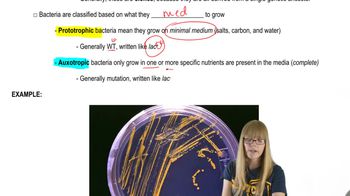Table of contents
- 1. Introduction to Genetics51m
- 2. Mendel's Laws of Inheritance3h 37m
- 3. Extensions to Mendelian Inheritance2h 41m
- 4. Genetic Mapping and Linkage2h 28m
- 5. Genetics of Bacteria and Viruses1h 21m
- 6. Chromosomal Variation1h 48m
- 7. DNA and Chromosome Structure56m
- 8. DNA Replication1h 10m
- 9. Mitosis and Meiosis1h 34m
- 10. Transcription1h 0m
- 11. Translation58m
- 12. Gene Regulation in Prokaryotes1h 19m
- 13. Gene Regulation in Eukaryotes44m
- 14. Genetic Control of Development44m
- 15. Genomes and Genomics1h 50m
- 16. Transposable Elements47m
- 17. Mutation, Repair, and Recombination1h 6m
- 18. Molecular Genetic Tools19m
- 19. Cancer Genetics29m
- 20. Quantitative Genetics1h 26m
- 21. Population Genetics50m
- 22. Evolutionary Genetics29m
5. Genetics of Bacteria and Viruses
Working with Microorganisms
Problem 4a
Textbook Question
Textbook QuestionFifteen bacterial colonies growing on a complete medium are transferred to a minimal medium. Twelve of the colonies grow on minimal medium.
The serine biosynthetic pathway is a three-step pathway in which each step is catalyzed by the enzyme product of a different gene, identified as enzymes A, B, and C in the diagram below.
Mutant 1 grows only on In addition to growth on , mutant 2 also grows on and . Mutant 3 grows on and . Identify the step of the serine biosynthesis pathway at which each mutant is defective.

 Verified Solution
Verified SolutionThis video solution was recommended by our tutors as helpful for the problem above
Video duration:
2mPlay a video:
Was this helpful?

 9:35m
9:35mWatch next
Master Bacteria in the Laboratory with a bite sized video explanation from Kylia Goodner
Start learningRelated Videos
Related Practice


